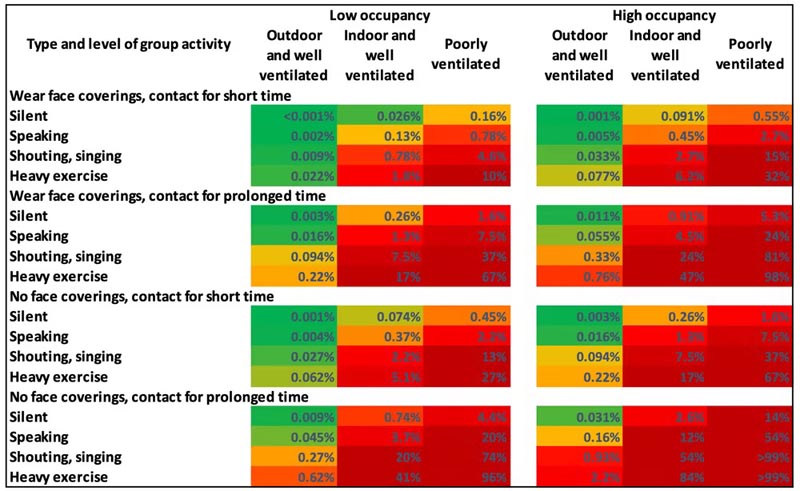Summary Some infectious diseases, including COVID-19, can undergo airborne transmission. This can happen in close proximity , but as time indoors increases, infections can occur in the air of the shared room despite distancing. We propose two infection risk indicators for this situation, i.e., relative risk parameter (Hr) and risk parameter (H). They combine the key factors that control the transmission of airborne diseases indoors:
COVID-19 outbreaks show a clear trend that is consistent with airborne infection and allow for recommendations to minimize the risk of transmission. Transmission in typical pre-pandemic indoor spaces is very sensitive to mitigation efforts. Previous outbreaks of measles, influenza and tuberculosis were also evaluated . Measles outbreaks occur at much lower risk parameter values than COVID-19, while tuberculosis outbreaks are observed at higher risk parameter values. Because both diseases are accepted as airborne, the fact that COVID-19 is less contagious than measles does not rule out airborne transmission. It is important that future outbreak reports include information on masking, ventilation and aerosol disposal rates, number of occupants, and duration of exposure, to investigate airborne transmission. Our analysis shows that mitigation measures are needed to limit airborne transmission in shared rooms in most indoor spaces whenever COVID-19 is spreading in a community. Effective measures include reducing vocalization, avoiding strenuous physical activities, shortening the duration of occupancy, reducing the number of occupants, using high-quality, well-fitting masks, increasing ventilation, improving the effectiveness of ventilation, and applying additional virus removal measures (such as HEPA filtration and UVGI disinfection). The use of multiple “layers of protection” is necessary in many situations, while a single measure (e.g., masking) may not be able to reduce the risk to low levels. We have shown that combinations of some or all of these measures can reduce H by about 0.01 person h2 m−3, so the expected number of secondary cases is substantially less than 1, even in the presence of an infectious person, so that major outbreaks are likely to be avoided. |
Comments ( The Conversation )
SARS-CoV-2, the virus that causes COVID, spreads primarily through airborne transmission. So the key to preventing transmission is understanding how particles in the air behave, which requires knowledge of physics and chemistry.
Air is a fluid made up of invisible molecules that move quickly and randomly, so particles in the air disperse over time indoors, such as in a room or on a bus.
An infected person can exhale particles containing the virus, and the closer you are to them, the more likely they are to inhale some particles containing the virus. But the longer the period you both spend in the room, the more the virus will spread.
If you are outdoors , the space is almost infinite, so the virus does not accumulate in the same way. However, someone can still transmit the virus if they are around them.
Viral particles can be emitted every time an infected person breathes, but especially if their breathing is deep (such as when exercising) or involves vocalization (such as talking or singing).
While wearing a well-fitting mask reduces transmission because the mask blocks the release of the virus, the infected person without a mask who sits quietly in a corner is much less likely to infect you than one who approaches you and a heated argument begins.
All SARS-CoV-2 variants are equally airborne, but the chance of getting COVID depends on the transmissibility (or contagiousness) of the variant (delta was more contagious than previous variants, but omicron is even more contagious) and how many people are currently infected (the prevalence of the disease).
At the time of writing, over 97% of COVID infections in the UK are omicrons and one person in 15 is currently infected (6.7% prevalence). While omicron appears more transmissible, it also appears to cause less severe illness, especially in vaccinated people.
Probability of becoming infected
In our study, we have quantified how different influences on transmission change your risk of getting sick:
- Viral factors (transmissibility/prevalence).
- Person factors (masked/unmasked, exercise/sitting, vocalization/silence).
- Air quality factors (indoor/outdoor, large room/small room, full/slightly filled, ventilated/unventilated).
We did this by carefully studying empirical data on how many people were infected in superspreading events where key parameters, such as room size, room occupancy, and ventilation levels, were well documented and representing how transmission occurs with a mathematical model.
The new chart provides a percentage chance of becoming infected in different situations.

A sure way to get COVID is to do a combination of things that take you to the dark red cells in the table. For example:
- Gathering with many people in an enclosed space with poor air quality, such as a gym, nightclub, or poorly ventilated school classroom.
- Doing something strenuous or loud, such as exercising, singing, or yelling.
- Leave your masks.
- Stay there for a long time.
To avoid getting COVID , try to stay in the green or amber spaces of the chart. For example:
|
While the chart provides an estimated figure for each situation, the actual risk will depend on specific parameters, such as exactly how many people are in what size room. If you want to enter your own data for a particular environment and activity, you can try our COVID-19 Aerosol Transmission Estimator .
















